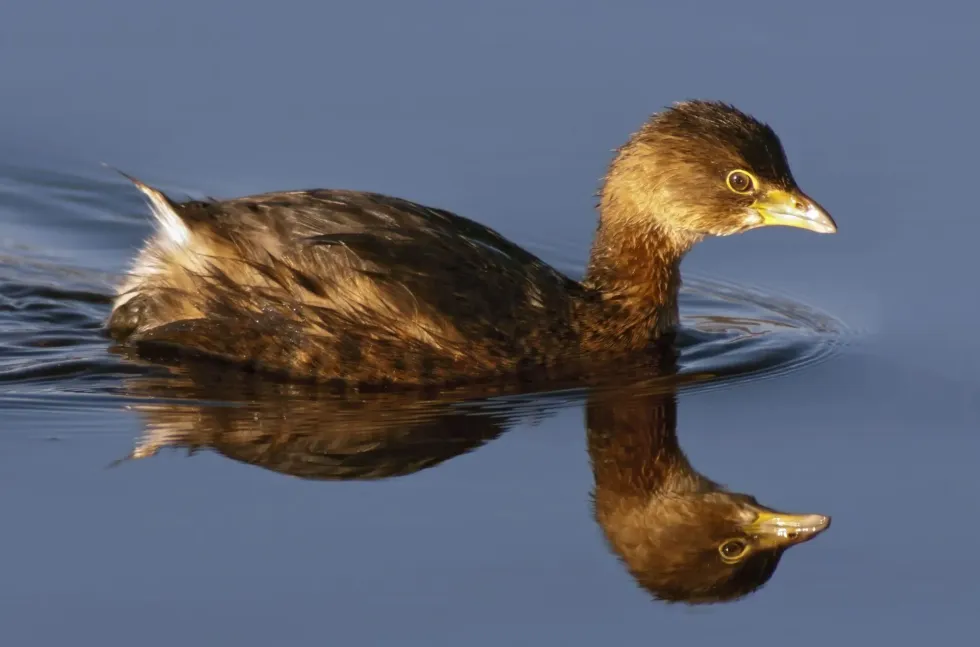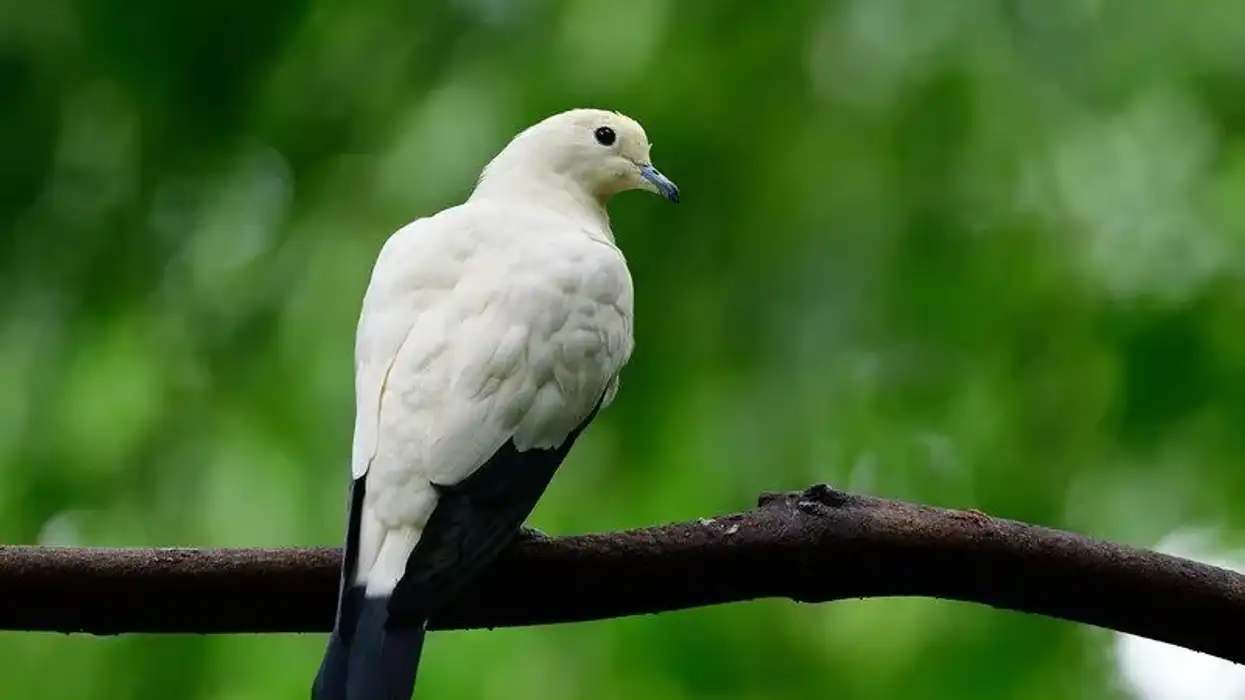A pied-billed grebe (Podilymbus podiceps) is a species of New World grebe that is distributed all over the freshwater habitats of North America. They have the largest distribution among all other North American birds of the aquatic grebe family in their natural habitat.
These North American birds are also known by several common names some of which are hell diver, American dabchick, water witch, and Carolina grebe.
The nesting range of the grebes extends from the northern parts of Canada in the south to southern South America in the south.
These diving birds enter Central America through the West Indies. The plumage of the pied-billed grebe, especially its plumage in the breeding season distinguishes them from the common North American grebes.
The pied-billed grebe's nest is found on emergent vegetation of freshwaters. These birds are aggressive in nature and are opportunistic feeders.
They dive in open water and readily attack whatever prey they get without hesitating. Like other grebes, the pied-billed grebes eat mostly by diving into ponds and lakes or in the aquatic emergent vegetation.
They are rarely seen in flight since the species migrate at night but are capable of flying long distances over water. They hide from their prey in open water either by diving or by sinking out of view.
To know more about this bird, keep on reading these facts. For more relatable content, check out these eared grebe facts and Atlantic puffin facts for kids.
Pied-Billed Grebe Interesting Facts
What type of animal is a pied-billed grebe?
A pied-billed grebe (Podilymbus podiceps) is a type of New World waterbird belonging to the grebe family of aquatic birds. They are primarily found in North American freshwater habitats with occasional visits to the marine aquatic environment.
What class of animal does a pied-billed grebe belong to?
The pied-billed grebes of Podicipediformes order and Podicipedidae family belong to the class Aves, the common class for all birds.
How many pied-billed grebes are there in the world?
The total population of the pied-billed grebes has currently not been determined. However, the bird is considered to be fairly common throughout their native range.
In 1967, the total population of breeding pairs was estimated to be around 25,990 pairs which equate to around 52,000 adults. Most of the individuals' nest was found floating in wetland habitats near emergent vegetation.
Even though the overall population trend of this water bird seems to be stable, there are some places where the bird species are declining in numbers.
The birds underwent a long-term significant population decline over the last four decades in North America due to climate change. Degradation and destruction of suitable breeding habitat over their nesting range have threatened the population of the pied-billed grebes over the last 50 years.
Poisoning due to pesticide contamination in vegetation has also resulted in widespread population declines of the bird. The breeding adult population has declined in places like New York, Massachusetts, Arkansans, New Jersey, Illinois, Ohio, and Vermont.
However, only 50% of the total pied-billed grebes have been monitored, there's is no significant information about the rest of their range.
There is also very little information regarding the conservation method of this bird. Close monitoring of their population and conservation measures are required to know the actual status of the bird in the wild.
Where does a pied-billed grebe live?
The pied-billed grebes are distributed over a large range extending from the coasts of Alaska and Canada up to the South American coasts. They are found throughout the United States and reach Central America through the Caribbean Islands of Bermuda and the West Indies.
The pied-billed grebe's winter is characterized by migration, the birds of the extreme northern zone migrate to the southern parts in the winter.
Migration takes place at night over water. During the migrating season, some birds may also end up in Europe by crossing the borders.
What is a pied-billed grebe's habitat?
Pied-billed grebes inhabit freshwater habitats consisting of emergent vegetation. These birds predominantly nest in lakes, ponds, and occasionally they might also nest in brackish water. Some individuals also inhabit salt marshes.
In the breeding season, they tend to nest near dense floating vegetation while they forage in open water. The bird also builds its nest in man-made wetlands created artificially. The birds typically nest in still water but sometimes they may be present in rivers as well.
Who do pied-billed grebes live with?
North American pied-billed grebes are less social than other grebes. They do not live by forming groups rather are found alone. In the breeding season, they live in pairs. The birds are comparatively more social in the breeding season than in the non-breeding season.
How long does a pied-billed grebe live?
An accurate lifespan of the pied-billed grebe is unknown. One bird was discovered in its first winter plumage which was believed to be over five years old.
How do they reproduce?
Like other grebes, the pied-billed grebes also form monogamous pairs during the breeding season. The pairs do not perform any mating display like other species of grebes. However, they have five stages of courtship which include advertising, pirouette, ripple dive, circle display, and triumph.
The individuals attract mates for themselves mainly by advertising. They face each other with a horizontally tilted head and the breast partially raised from the water. Finally, when the pairs are formed, they perform triumph displays by circling their mates.
The breeding season of the pied-bellied grebes lasts from April to October. Mating takes place in a floating nest in the water while the birds lay eggs on top of emergent vegetation. The pied-billed grebes are capable of laying up to two broods in a single season.
Both the male and female take part in the construction of the breeding nest. The floating nest is tied to the vegetation in the water.
The pied-billed grebe female lays 2-10 small bluish-white eggs in a single clutch. The eggs are incubated by both parents and after an incubation period of 23 days, the pied-billed grebe baby appears. The chicks leave the nest one day after the eggs hatch.
What is their conservation status?
Pied-billed grebes are listed as a species of Least Concern in the IUCN Red List. Even though these water birds are threatened by habitat loss, they currently have a large nesting range, the largest of all aquatic grebes.
They are also common throughout the range which suggests that the species probably has a large breeding population. However, some human actions act as leading conservation concerns for the North American birds.
Degradation of their habitat is a major concern that these aquatic grebes are currently facing.
In some states, they have been classified as Endangered because of drastic population declines. However, these adaptive water birds have shown promises of increasing their numbers in the future by nesting in artificial and man-made ponds.
Pied-Billed Grebe Fun Facts
What do pied-billed grebes look like?

The body of the bird is covered with a brown plumage all over with dark brown feathers on the crown and back. They have a chicken-like bill that is small and it ends in a hook. The color of the bill changes in the breeding season.
The bill becomes bluish-white with a vertical black bar during this time. The underparts are white in color. The summer plumages slightly differ from the winter plumages.
In winter, they have a pale throat and the bill changes its color. The black band disappears in winter.
The upper parts remain the same. The pied-billed grebe feet are located at the back of the body. The pied-billed grebe juvenile is covered with dull orange feathers.
How cute are they?
The birds are pudgy and quite small. This contributes to their cuteness and makes them some of the cutest birds around.
How do they communicate?
The pied-billed grebes mainly communicate by vocalizations. The pied-billed grebe sounds like the yellow-billed cuckoo.
How big is a pied-billed grebe?
The length of a pied-billed grebe ranges between 12-15 in (30.5-38.1 cm). They are similar in size to horned grebe.
How fast can a pied-billed grebe fly?
The pied-billed grebes are fast swimmers, they travel by swimming rather than flying. However, their speed is unknown.
How much does a pied-billed grebe weigh?
The weight of a pied-billed grebe ranges between 8.9-20 oz (253-568 g).
What are the male and female names of the species?
The male and a female grebe are referred to as a cock and hen respectively.
What would you call a baby pied-billed grebe?
The babies of the pied-billed grebe are known as chicks.
What do they eat?
The pied-billed grebes are omnivorous in nature, they dive to feed on aquatic insects and small crustaceans like crawfish. Their diest mostly consists of fish. They can also feed on small fish and small amphibians like frogs and tadpoles. They sometimes consume plants and also on their own feathers. The chicks feed on insects.
Are they dangerous?
No, they are not dangerous.
Would they make a good pet?
No, they are wild in nature and do not form good pets.
Did you know...
Pied-billed grebes hide from their predators by diving underwater keeping only a part of their head above water.
Why is the pied-billed grebe endangered?
The pied-billed grebes are not endangered in official terms, these birds are regarded as species of Least Concern by the IUCN Red List. They are common water birds that predominantly inhabit lakes and ponds.
However, their populations have faced some uneasy turbulence in their native range making them endangered in certain parts. The entire species is considered to be endangered in Rhode Island, Kentucky, Massachusetts, Connecticut, and New Hampshire.
While in New Jersey only the breeding populations of adults are endangered.
Loss of wetlands has resulted in declining breeding and winter habitats of the bird. Increasing pesticide poisoning due to human interferences in their nesting range has also caused a great impact on their population which made the water birds endangered in these states.
Is a grebe a duck?
No, a grebe is not a duck. Both of them are waterbirds but the two are not the same. Ducks have webbed feet while grebes have developed feet with toes.
Here at Kidadl, we have carefully created lots of interesting family-friendly animal facts for everyone to discover! Learn more about some other birds from our Indian cuckoo interesting facts and owl surprising facts pages.
You can even occupy yourself at home by coloring in one of our free printable mallard duck coloring pages.









